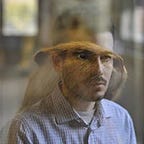The boundaries of an organism (part 1) — The Markov blanket
How an organism emerges and sets apart from the rest of the environment? How it doesn’t lose its integrity and fade away?
In the previous posts we pointed out the difficulties of finding a fully coherent explanation for emerging unity, autonomy and agency of biological systems — conditions for any form of cognition — in order to sketch out a dynamical model of self-organization, set up upon the naturalistic foundation of autopoietic theory.
The primary problem to solve is the differentiation between organisms and environment. Namely, what are the boundaries of an autonomous biological system? How an organism maintains its integrity whilst interacting (action-perception) with the environment? In other words — given a biological environment, how a self-organized unity emerges and maintain itself? -
One of the most relevant attempts to solve this puzzle comes from the field of computational neuroscience and machine learning, where few years ago professor Karl Friston began to address this subject adopting a statistical approach. In particular, we introduce here the concept of Markov Blanket, through which is possible to provide a statistical-probabilistic model of the emergence of an organism (any self-organized system) in the environment by means of action-perception cycles. For the moment, we will avoid statistics notation, rather, we will offer a simplified description of the mechanisms behind this subject, in order to ensure continuity with the issues outlined in the previous posts.
A Markov blanket is a boundary that separates the internal states of a system from the external states, i.e. a Markov blanket separates an organism from the environment. Internal and external states are not in direct contact and they cannot influence each other directly, rather, any interaction between them is mediated through the Markov blanket. The blanket has not to be seen as an imaginary boundary line, but is itself a set of states, constituted of two subsets — active states and sensory states. The active states are influenced by the internal states of the system but not from external states, while sensory states are influenced by external states and not from internal states. In other words, external environmental factors are able to perturbate the sensory portion of an organism contour but not directly the inside of the biological system, while processes which are internal to the system are able to perturbate the active portion of the organism’s contour but not directly the surrounding environment. [1] The emergence of this sensory-active peripherical part of a biological system, the Markov blanket, is what allows a portion of an undistinguished biological environment to emerge as a bounded unity, becoming the “self-reference dimension” for autopoiesis and self-organization.
Already from this minimal scheme, it is possible to glimpse a system that while remaining an open thermodynamic system (exchanging energy with the environment) can constitute itself as an autonomous system. Indeed, thanks to the indirect-mediated nature of its interaction with the environment and the differentiation of active and sensory processes, the system acquires at least one of the two features that in the previous posts have been indicated as necessary for achieving autonomy — organizational closure. Indeed, thanks to the Markov blanket mediation, the organism is able to couple with environmental elements without structurally mutating, but keeping intact its own integrity within its boundaries, possible states and structural constraints.
In addition, a “blanketed” biological system exhibits a possible configuration of that — directionality along a continuous active-sensory cycle — proposed by enactivists. Indeed, an organism interacts with the environment recursively performing a control on external inputs on one side (filtering, categorizing, etc.), and acting “on an informed basis” on the other side [2]. The exact mechanism behind this cycle will become clearer when we will deal with the principles of free energy minimization and active inference.
At this stage it’s worth clarifying that the principles implied by the Markov blanket which are here described — processes, functions, relations — do not necessarily entail any intrinsic causal relation, rather, they formalize statistical properties of self-organization. This is particularly important in order to understand the potential multiplicity and mutability of Markov blankets and active-sensory cycles, which is essential for the emergence of complex multilevel hierarchical and heterarchical configurations of systems, typical of any multi-cellular living system [2]. For the moment, let’s stick to a minimal one-dimensional Markov blanket scheme and let’s try to outline more specifically its configuration.
In order to do so, after this general introduction, in the next part we will explain the meaning of two essential concepts used in the above introductive definition: state and influence between states.
[1] Friston, K. Life as we know it. Journal of the Royal Society Interface, 2013.
[2] Palacios, E. R., Razi, A., Parr, T., Kirchhoff, M., & Friston, K.. Biological self-organisation and Markov blankets. BioRxiv, 2017.
